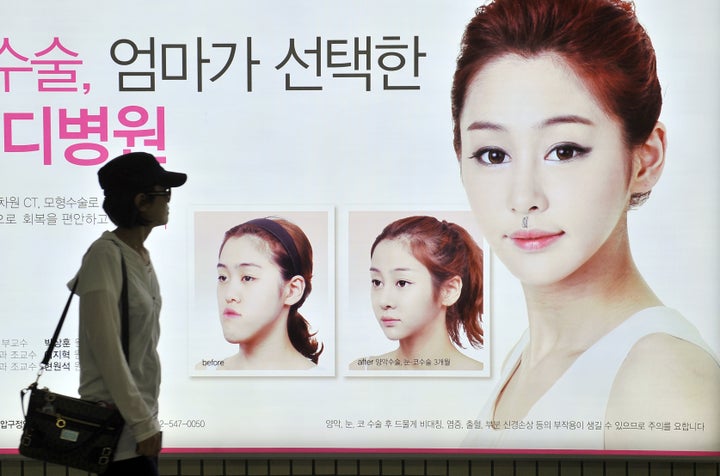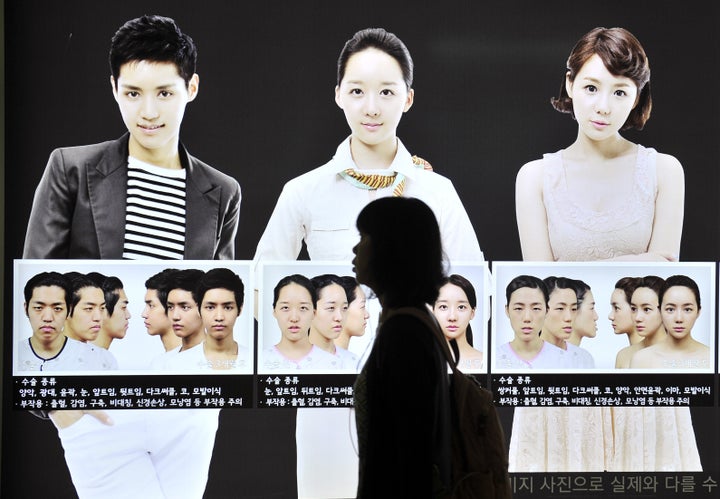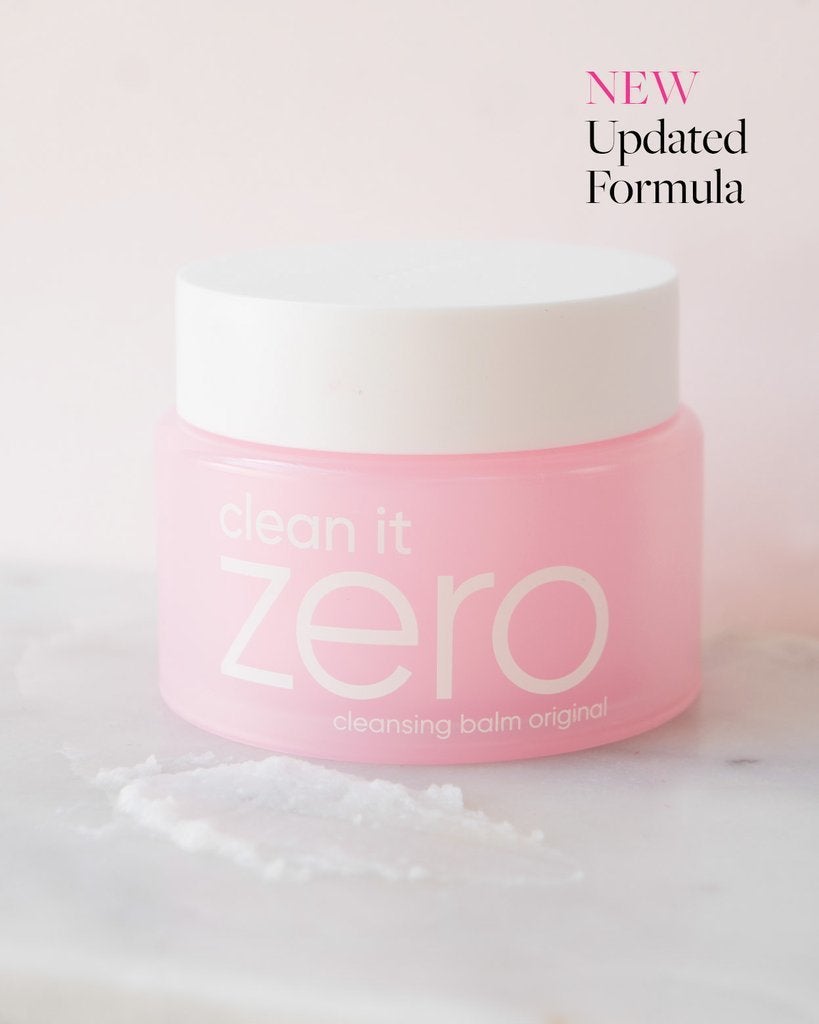“I just wanted to be prettier.”
As a 20-year-old woman living in Seoul, South Korea, and working in the television industry, G (who has asked to remain anonymous because of contractual obligations with her employer) was determined to alter her face for both personal and professional reasons. She decided to undergo plastic surgery to heighten her nose bridge and, pleased with the results, got another cosmetic procedure to add a crease to her eyes a few years later. Imbued with a newfound sense of confidence, G was thrilled by how her altered facial features began to affect the rest of her life.
“I gained confidence in areas of my appearance that I had complexes about all my life,” she told HuffPost. “I also feel that my personality began to change as well. I found myself becoming more of an extrovert after my surgery.”

G is far from an anomaly in using cosmetic surgery to improve her life. In Korean culture, she said, plastic surgery is viewed as an “enhancement” or extension of makeup, thus normalizing its use for everyone from young teens to older adults looking for anti-aging solutions.
Dr. Joo Kwon, the CEO of JK Plastic Surgery Center, one of the largest surgery clinics in South Korea and the only clinic officially accredited by the South Korean government, expressed this attitude plainly.
“Many patients are content with their appearance but have some small fixes or want to maintain their youthfulness,” Kwon told HuffPost. “If someone feels as if a feature or an aspect of their appearance is interfering with their quality of life, surgery could assist in that manner.”
“Plastic surgery is not just about being ‘normal’ or ‘passable,’ but about moving forward and being ‘above normal’ for Koreans. Compared to Koreans’ obsession with education or religion, the plastic surgery boom is almost nothing.”
- So Yeon Leem, Seoul National University researcher
Today, South Korea is widely considered the “plastic surgery capital” of the world, boasting the highest number of cosmetic procedures per capita worldwide, with more than 600 clinics in Seoul alone. In a 2011 report, the International Society of Aesthetic Plastic Surgery estimated that nearly 650,000 cosmetic procedures were performed in South Korea that year. South Korea’s international plastic surgery clientele has expanded significantly as well: About 50,000 foreign patients received plastic surgery in the country last year, paying a collective sum of $189 million for double eyelid surgeries, double jaw surgeries (a procedure that cuts and rearranges the upper and lower jawbones to create a slimmer jawline) and other various facial and body modifications.
When It All Started
Plastic surgery first entered mainstream South Korean culture after the Korean War in the late 1950s and early 1960s. American military doctors performed double-eyelid surgeries to fix the “oriental eyes″ of native patients, and the use of reconstructive surgery as a means of self-improvement quickly caught on across the war-torn peninsula. In 1974, the Supreme Court of South Korea approved cosmetic plastic surgery as a medical practice, bringing legal and social legitimization to the fast-growing business.

Now, plastic surgery is embedded within urban South Korean culture. It’s not uncommon for high school students to receive cosmetic surgery as a graduation present, and there are numerous apps, YouTube videos and blogs available to help people select the clinic and physiological redesign that’s right for them. And while there has been a recent increase in Korean men using plastic surgery to alter their appearance, South Korea’s booming plastic surgery industry continues to largely have an impact on women. According to a 2015 survey by Gallup Korea, 14% of South Korean women have undergone some form of plastic surgery — although that statistic jumps to 30% for women in their 20s in particular. In contrast, a Pew Research survey found that only 7% of women in the United States have had plastic surgery, with breast augmentation and liposuction listed as the most popular cosmetic procedures in the country.
The Impetus
Many Western scholars and media outlets attribute the popularity of plastic surgery in South Korea to the residual effects of imperialism, suggesting that Koreans are going under the knife in hopes of appearing more white. But this explanation “flattens and erases the different meanings and activities around the plastic surgery practices of Korean women,” said So Yeon Leem, a researcher at Seoul National University.
“Plastic surgery to look white is an old trend which occurred before the 1990s. Korean women want to achieve a ‘universal beauty’ through plastic surgery,” Leem told HuffPost.

“It’s not fair to say that Korea puts more value on physical appearances than other societies. Western culture has its own obsession with beauty standards,” she added.
Similarly, “Americans put more emphasis on body procedures so you will see a higher rate of breast augmentation and liposuction than in Korea,” Kwon said. “Standards of beauty vary from each country, and the statistics for which procedures patients get differ.”
Arguing against the idea that Koreans have uniquely vain and harsh standards of beauty, Leem said this rationale fails to comprehend Korea’s “enthusiasm for education, self-improvement and enhancement.”
“Plastic surgery is not just about being ‘normal’ or ‘passable,’ but about moving forward and being ‘above normal’ for Koreans,” she said. “Compared to Koreans’ obsession with education or religion, the plastic surgery boom is almost nothing.”
Negative Consequences And Backlash
Still, the social pressure to be “above normal” comes with its own negative consequences. One young woman, Ashley Kim, emphasized the unhealthy cost of this mindset, recalling her family’s recurring comments on her appearance as a child and their advice for getting plastic surgery — such as, “Why don’t you get your eyes done?” or “No one will marry you with a nose like that” or “You must look this way to get a job.”
“Koreans believe they won’t get the job or the man or even be acknowledged if they don’t look a certain way,” Kim, 28, told HuffPost.
“Plastic surgery to look white is an old trend which occurred before the 1990s. Korean women want to achieve a ‘universal beauty’ through plastic surgery.”
- Leem
Kim said she worries about the limitless nature of self-improvement and how it feels as though there are countless ways to modify and correct your face.
“You fix one part of your face and the rest just doesn’t look right,” she said. “So you continue hoping it will all fall into symmetry, but it never really does, right?”
In spite of, or perhaps because of, the ubiquitous nature of plastic surgery in South Korean metropolises, backlash against Korean beauty expectations has been steadily emerging. Seoul Metro has announced a plan to ban plastic surgery ads from the city’s subway stations in response to criticism against the high volume of advertisements encouraging cosmetic procedures. And the Escape the Corset movement, pioneered by photographer Jeon Bora, celebrates women who defy conventional beauty norms, creating a new space for women to speak freely about the pressure to be beautiful in Korea.
But for many Korean women, the decision to get plastic surgery cannot be neatly categorized as either self-improvement or a cry for help, and beauty standards in Korean society, while strenuous and flawed, are not the “draconian” practices that many news outlets portray them to be.
The simplistic understanding of plastic surgery as oppressive and singular to Korea is wrong, Leem said, and demonizing these procedures “stops consumers of plastic surgery from talking about their motivations, satisfactions, concerns, anxieties and hopes in open spaces.”
G, for one, has no regrets about her cosmetic procedures and believes that the changes to her appearance have noticeably benefited her as a member of society.
“There is definitely a part of me that can increase my confidence by making sure that I look as good on the outside as I do on the inside,” G said. “Many people say that what’s on the inside is more important than outer beauty, but I don’t think it has to be so separated.”
